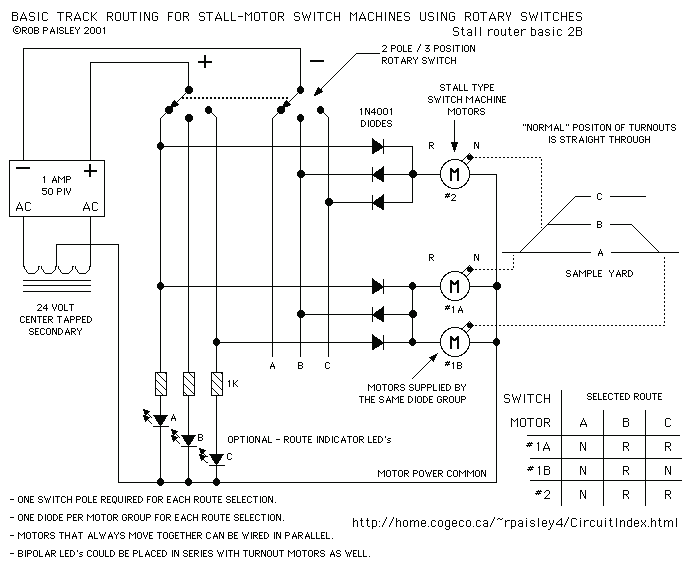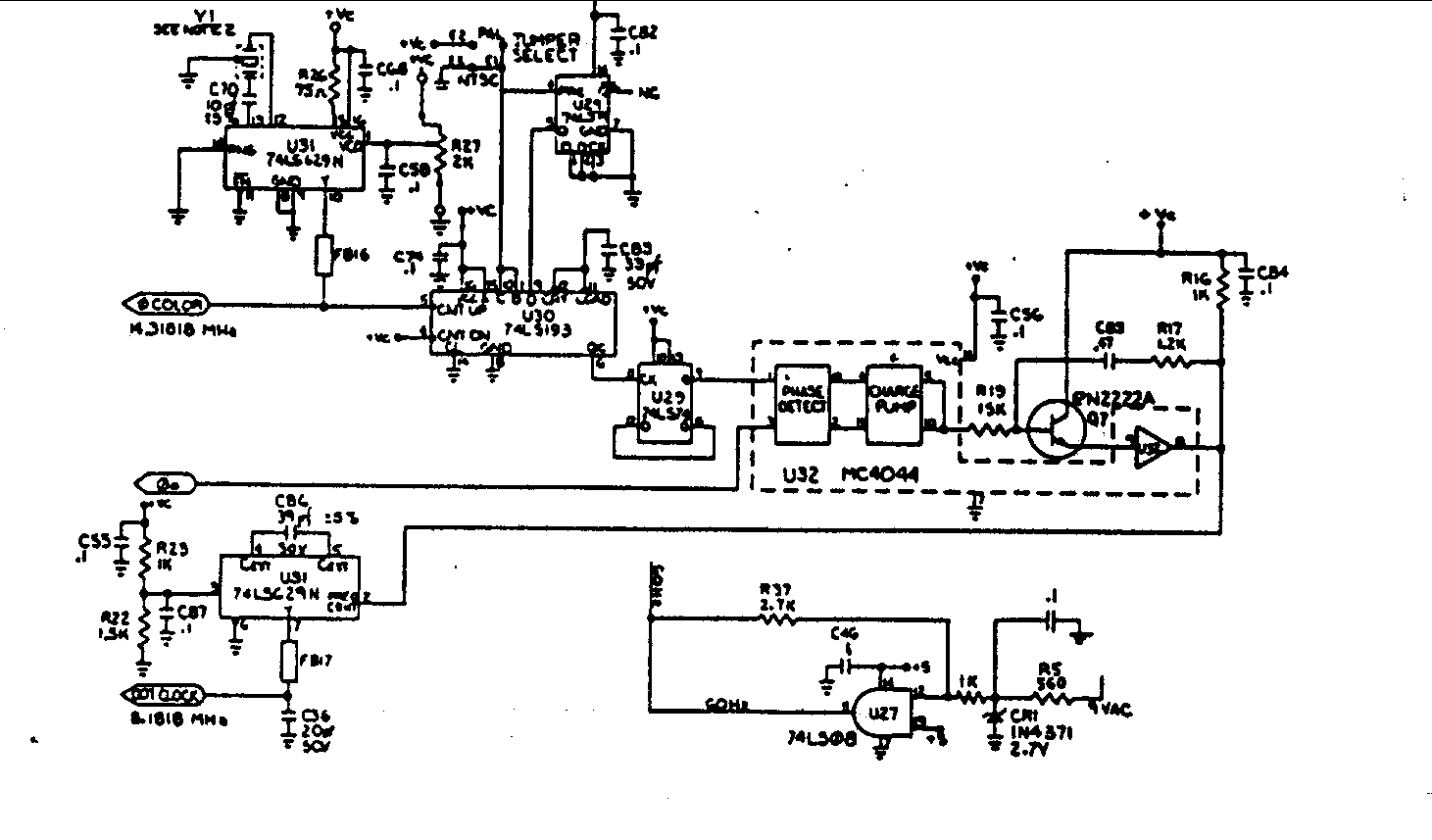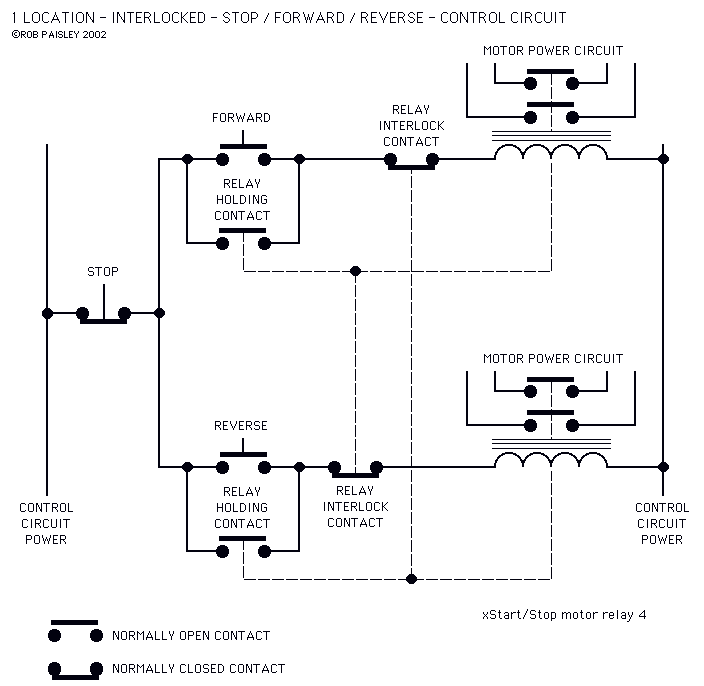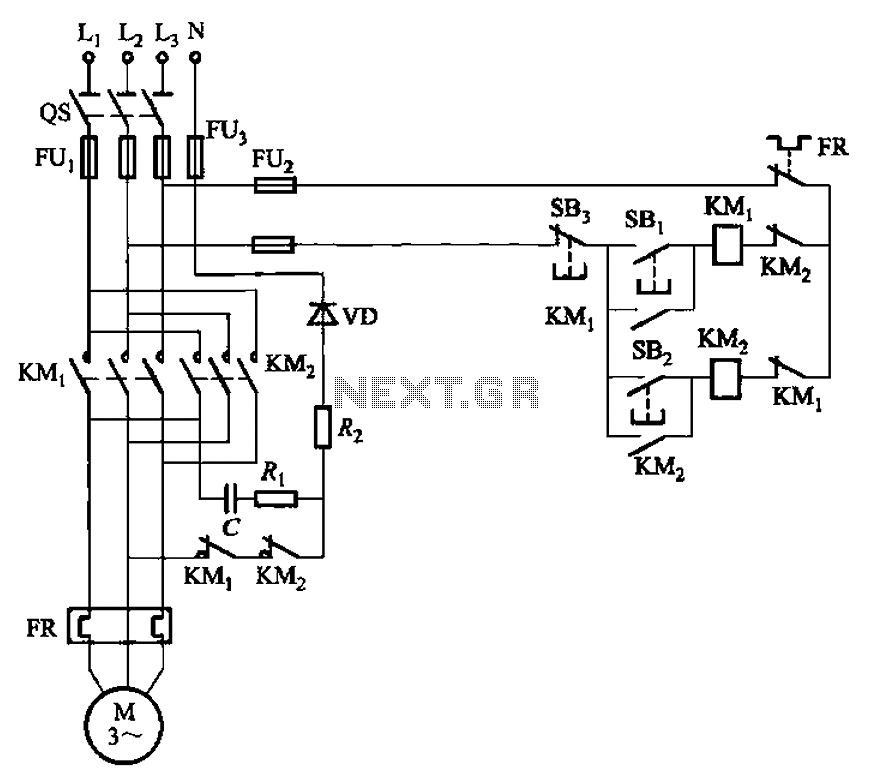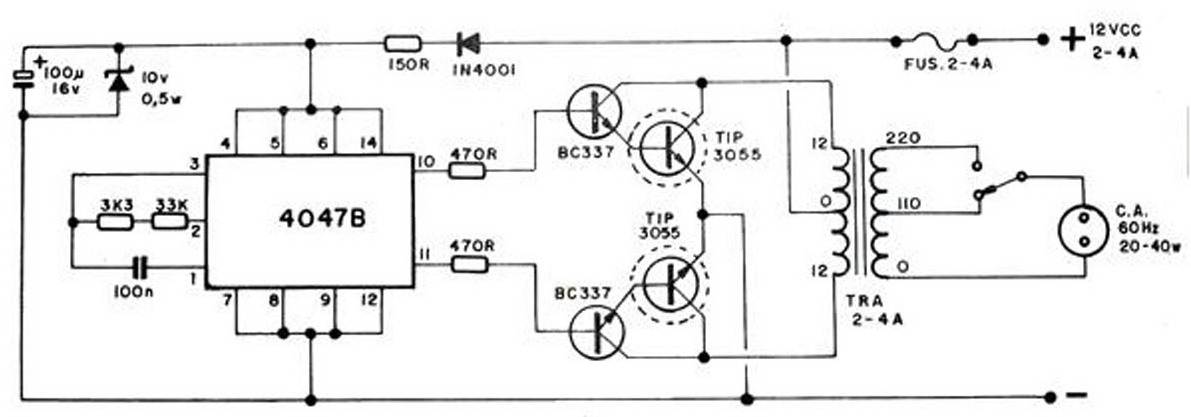
Controlling high-current circuits
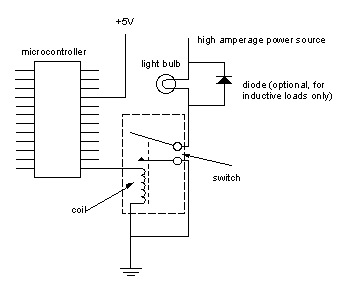
Digital output from a microcontroller is typically a low-amperage signal. For example, when a pin is set HIGH on the microcontroller (in Wiring/Arduino, it is digitalWrite(somePin, HIGH);), the voltage from that pin is usually +3.3V or +5V, with the current being generally 10 milliamps or less. This is adequate for controlling an LED, which requires minimal current. However, most devices that require control need more current. To manage this, an intermediary component is necessary between the microcontroller and the device, which can handle the small voltage and current. Relays and switching transistors are commonly utilized for this function. A relay operates as a switch controlled by a small electric current. It exploits the principle that an electric current passing through a wire generates a surrounding magnetic field. When an iron shaft is placed inside a coil of wire and current flows through the wire, the magnetic field shifts the iron shaft. If the shaft is part of a switch, the application of current to the coil can turn the switch on and off by moving the shaft to close the contact. A diode is typically placed in parallel with the load to protect against blowback voltage generated when the load is a motor, solenoid, or other inductive load. The current required to energize the coil is very low (less than 10 milliamps), allowing it to be powered by an output pin of the microcontroller. The current flowing through the switch can be significantly higher. The lamp circuit is primarily separate from the microcontroller, utilizing a distinct power source that provides the necessary amperage and voltage to activate the lamp. The power source, lamp, and relay switch are arranged in series, with the opposite side of the switch grounded. When the coil is energized, the magnetic force moves the switch, completing the lamp circuit and turning the lamp on. It is important to note that the coil and lamp circuit share the same ground, applicable in DC circuit switching (with further details on AC provided later). Relays can also be employed to replace switches in existing electronic devices; by substituting a switch with a relay coil, a microcontroller can control the device as if the button were pressed. However, relays are mechanical switches and may be slower (taking a few milliseconds to close), making them ineffective for rapid on-off switching. In scenarios requiring quick switching of high current circuits, a switching transistor is preferable. A transistor functions as either a switch or an amplifier, enabling control of a large current with a smaller current, similar to a relay, but operates much faster due to its non-mechanical nature. This discussion will focus on transistors used as switches, specifically bipolar transistors, which come in two major types: NPN and PNP. Each type has three connections: base, collector, and emitter (while FETs have gate, source, and drain). A small voltage or current applied to the base of a transistor allows a larger current to flow from the collector to the emitter. NPN transistors require a small positive voltage on the base relative to the collector to activate, while PNP transistors need a small negative voltage on the base.
The digital output from a microcontroller, typically characterized by low-amperage signals, is essential for interfacing with various electronic components. The microcontroller's output pin can be set to HIGH, resulting in a voltage of either +3.3V or +5V, and a current limit of approximately 10 milliamps. This output is sufficient for low-power devices like LEDs, but many applications necessitate controlling devices that draw more current.
To bridge the gap between the microcontroller and higher current devices, components such as relays and switching transistors are employed. Relays function as electromechanical switches that can be activated by small currents. The principle of operation involves generating a magnetic field through a coil when current flows, which then moves an iron shaft to open or close a switch. This mechanism is particularly effective for controlling AC or DC loads, with the inclusion of a flyback diode in parallel with inductive loads to prevent voltage spikes that can damage the circuit.
In contrast, transistors provide a faster switching alternative. Bipolar transistors, which include NPN and PNP types, allow for significant current flow from the collector to the emitter based on a smaller input current at the base. This functionality is critical in applications requiring rapid switching without the mechanical delays associated with relays. Transistors can be integrated into various circuit designs to achieve efficient control of higher power devices while maintaining the low current output of the microcontroller.
The choice between using a relay or a transistor depends on the specific requirements of the application, including the need for speed, current handling capabilities, and the nature of the load being controlled. Understanding these components' operational principles is crucial for designing robust and effective electronic circuits.Digital output from a microcontroller is typically a low-amperage signal. For example, when you put a pin HIGH on the microcontroller (in Wiring/Arduino, it`sG‚ digitalWrite(somePin, HIGH); ), the voltage coming from that pin is typically +3. 3V or +5V, and the amperage coming from it is typically 10 milliamps or less. This is fine if you`re contro lling an LED, whose required amperage is tiny. Most devices you`d want to control require more current than that. In order to control them, you need something in between your microcontroller and the device that can be controlled with this small voltage and amperage. Relays and switching transistors are most often used for this purpose. A relay is a switch that`s controlled by a small electric current. Relays take advantage of the fact that when you pass an electric current through a wire, a magnetic field is generated surrounding the wire as well.
When you place an iron shaft inside a coil of wire and pass current through the wire, the magnetic field moves the iron shaft. If that iron shaft is part of a switch, the switch can be turned on and off by putting current through the coil, which moves the shaft, closing the contact (see diagram below).
Note the diode in parallel with the load here. This is used only when the load is a motor, solenoid, or some other inductive load, and when it is switched off, will generate a blowback voltage. The diode protects against this. See my motes on motors for more detail. The current needed to move the shaft in the coil is very low (less than 10 milliamps) so the coil can be energized by an output pin of our microcontroller.
The current that can flow through the switch, however, is much higher. The lamp circuit is mostly separate from the microcontroller. A separate power source, with the amperage and voltage needed to turn on the lamp, is used. The power source, the lamp, and the switch side of the relay are all placed in series, and the opposite side of the switch is grounded. When the coil is energized, the switch is physically moved by the magnetic force created, the lamp circuit is completed, and the lamp turns on.
Notice that the coil and the lamp circuit are connected to the same ground, however. This applies only if we are switching a DC circuit (more on AC later). Relays are also useful when you want to replace a switch in an existing electronic device. If you replace the switch with the coil of a relay, the microcontroller can control the device just as if the button were pressed. Because a relay is a mechanical switch, it can be somewhat slow (a few milliseconds to close). So relays aren`t very effective when you want to turn them on and off rapidly. Sometimes you need to switch a high current circuit rapidly. In this case you would use a switching transistor. A transistor is a device that can work as a switch or an amplifier. It allows control of a large current by a smaller current as does a relay. Unlike a relay, however, a transistor is not mechanical, and can operate much faster than a relay. For the moment, we`ll discuss using transistors as switches. There are several types of transistors and they come in two major classes: bipolar transistors, and field-effect transistors, or FETs.
For the moment, we`ll be talking only about bipolar transistors. All, however have some similar properties. They all have three connections, referred to as the base, the collector, and the emitter (on FET transistors, the three connections are the gate, the source and the drain). By putting a small voltage/current on the base of a transistor, you allow a larger current to flow from the collector to the emitter.
Among bipolar transistors, there are two types: NPN transistors, and PNP transistors. NPN transistors require a small positive voltage on the base relative to the voltage on the collector to turn on, whereas PNP transistors require a small negative voltage on the base. We`ll use NPN 🔗 External reference
The digital output from a microcontroller, typically characterized by low-amperage signals, is essential for interfacing with various electronic components. The microcontroller's output pin can be set to HIGH, resulting in a voltage of either +3.3V or +5V, and a current limit of approximately 10 milliamps. This output is sufficient for low-power devices like LEDs, but many applications necessitate controlling devices that draw more current.
To bridge the gap between the microcontroller and higher current devices, components such as relays and switching transistors are employed. Relays function as electromechanical switches that can be activated by small currents. The principle of operation involves generating a magnetic field through a coil when current flows, which then moves an iron shaft to open or close a switch. This mechanism is particularly effective for controlling AC or DC loads, with the inclusion of a flyback diode in parallel with inductive loads to prevent voltage spikes that can damage the circuit.
In contrast, transistors provide a faster switching alternative. Bipolar transistors, which include NPN and PNP types, allow for significant current flow from the collector to the emitter based on a smaller input current at the base. This functionality is critical in applications requiring rapid switching without the mechanical delays associated with relays. Transistors can be integrated into various circuit designs to achieve efficient control of higher power devices while maintaining the low current output of the microcontroller.
The choice between using a relay or a transistor depends on the specific requirements of the application, including the need for speed, current handling capabilities, and the nature of the load being controlled. Understanding these components' operational principles is crucial for designing robust and effective electronic circuits.Digital output from a microcontroller is typically a low-amperage signal. For example, when you put a pin HIGH on the microcontroller (in Wiring/Arduino, it`sG‚ digitalWrite(somePin, HIGH); ), the voltage coming from that pin is typically +3. 3V or +5V, and the amperage coming from it is typically 10 milliamps or less. This is fine if you`re contro lling an LED, whose required amperage is tiny. Most devices you`d want to control require more current than that. In order to control them, you need something in between your microcontroller and the device that can be controlled with this small voltage and amperage. Relays and switching transistors are most often used for this purpose. A relay is a switch that`s controlled by a small electric current. Relays take advantage of the fact that when you pass an electric current through a wire, a magnetic field is generated surrounding the wire as well.
When you place an iron shaft inside a coil of wire and pass current through the wire, the magnetic field moves the iron shaft. If that iron shaft is part of a switch, the switch can be turned on and off by putting current through the coil, which moves the shaft, closing the contact (see diagram below).
Note the diode in parallel with the load here. This is used only when the load is a motor, solenoid, or some other inductive load, and when it is switched off, will generate a blowback voltage. The diode protects against this. See my motes on motors for more detail. The current needed to move the shaft in the coil is very low (less than 10 milliamps) so the coil can be energized by an output pin of our microcontroller.
The current that can flow through the switch, however, is much higher. The lamp circuit is mostly separate from the microcontroller. A separate power source, with the amperage and voltage needed to turn on the lamp, is used. The power source, the lamp, and the switch side of the relay are all placed in series, and the opposite side of the switch is grounded. When the coil is energized, the switch is physically moved by the magnetic force created, the lamp circuit is completed, and the lamp turns on.
Notice that the coil and the lamp circuit are connected to the same ground, however. This applies only if we are switching a DC circuit (more on AC later). Relays are also useful when you want to replace a switch in an existing electronic device. If you replace the switch with the coil of a relay, the microcontroller can control the device just as if the button were pressed. Because a relay is a mechanical switch, it can be somewhat slow (a few milliseconds to close). So relays aren`t very effective when you want to turn them on and off rapidly. Sometimes you need to switch a high current circuit rapidly. In this case you would use a switching transistor. A transistor is a device that can work as a switch or an amplifier. It allows control of a large current by a smaller current as does a relay. Unlike a relay, however, a transistor is not mechanical, and can operate much faster than a relay. For the moment, we`ll discuss using transistors as switches. There are several types of transistors and they come in two major classes: bipolar transistors, and field-effect transistors, or FETs.
For the moment, we`ll be talking only about bipolar transistors. All, however have some similar properties. They all have three connections, referred to as the base, the collector, and the emitter (on FET transistors, the three connections are the gate, the source and the drain). By putting a small voltage/current on the base of a transistor, you allow a larger current to flow from the collector to the emitter.
Among bipolar transistors, there are two types: NPN transistors, and PNP transistors. NPN transistors require a small positive voltage on the base relative to the voltage on the collector to turn on, whereas PNP transistors require a small negative voltage on the base. We`ll use NPN 🔗 External reference
Warning: include(partials/cookie-banner.php): Failed to open stream: Permission denied in /var/www/html/nextgr/view-circuit.php on line 713
Warning: include(): Failed opening 'partials/cookie-banner.php' for inclusion (include_path='.:/usr/share/php') in /var/www/html/nextgr/view-circuit.php on line 713
